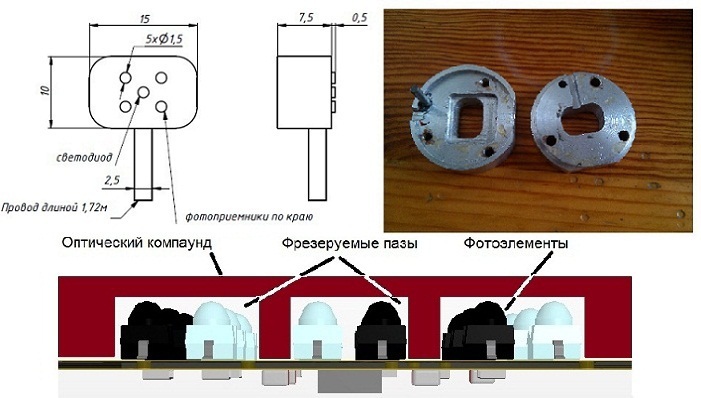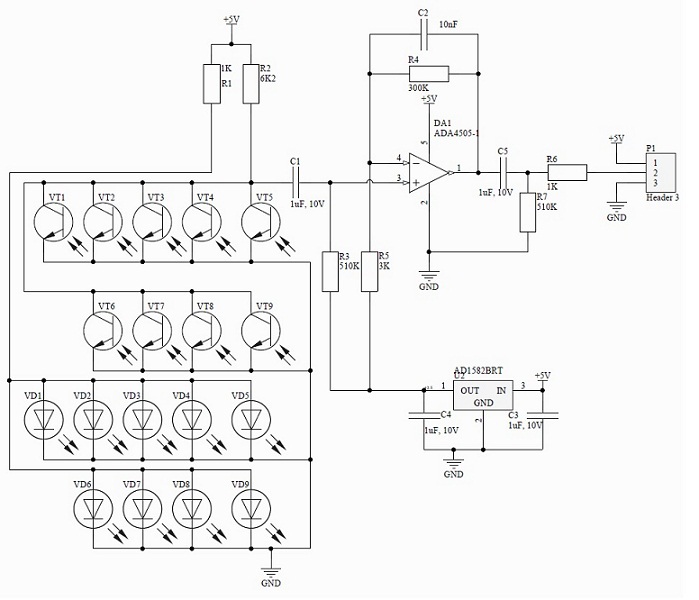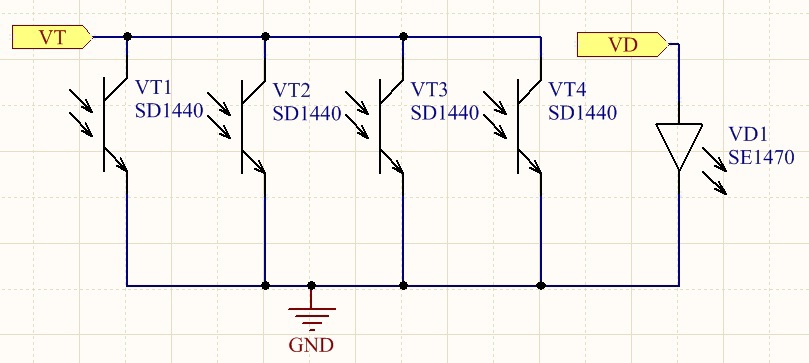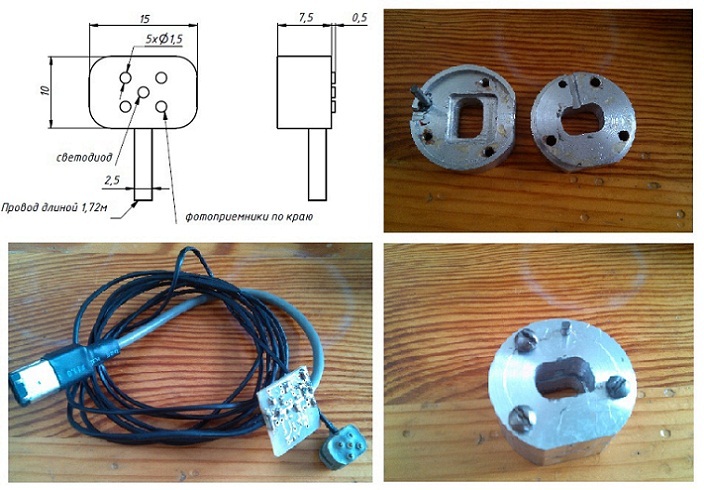Heart rate sensor device. Part 2 - sensors

In this article, you will learn about several details that you need to pay attention to when developing photo plethysmograph sensors.
Introduction
In the previous article, you got acquainted with the design of a sensor measuring a pulsogram . Today I will share some developments that may be useful in choosing the elemental base of the plethysmograph and developing its electrical circuit. They will help improve the quality of the useful signal, which is primarily affected by the following factors:
- lack of artifacts;
- the presence of a pronounced pulse wave at the registration point;
- sensitive element design.
An artifact is a change in the waveform that is not related to the useful component and is spectrally and amplitude-similar to it.
There are several sources of artifacts:
- the movement of a person using a photoplethysmograph, a relative light source, natural or artificial, for example, moving shadow from the sun during sports;
- the movement of a light source relative to a person or a change in the brightness of that source. For example, flicker of fluorescent lamps;
- movements of body parts not related to the pulse causing movements of the photoplethysmograph or points of the body in the place where the sensing element is installed. For example, movements of the bones of the forearm arising from movements of the fingers, movements of the bones of the head associated with speech and facial expressions.
In addition to artifacts, the quality of the pulse measurement depends on the severity of the pulse wave. In the same person, the pulse can be manifested very well and very poorly. For example, I watched the pulse change many times during a three-hour computer psycho-physiological test. The pulsogram was measured from the earlobe. In this case, the signal worsened over time. This could happen quite quickly - in half an hour, and is supposedly due to the fact that the ear clip impairs blood flow, as well as with the subject's forced immobility.
A similar situation is observed when measuring pulse from the phalanx of the finger. A change in the room temperature or a slight change in a person’s posture and the resulting shift of the registration point a short distance can lead to a decrease in the signal level or even to its disappearance.
When measuring the pulse from the temple, the problem of the lack of signals is exacerbated. The area of the temple is larger than the area of the finger, it is more difficult to find the point at which the pulse is better manifested, and more likely that the user will wear the sensor incorrectly.
Multichannel Sensors
To solve the described problem, a principle common in the technique can be applied - duplication, which in this case involves the use of a sensor with several sensitive elements. The circuit diagram that implements such an idea is shown in the following figure.

I foresee skeptical thoughts of readers about parallel-connected LEDs. Please do not judge strictly, since this is a prototype that should not have been used for a long time.
LEDs and phototransistors on a printed circuit board are arranged in pairs. The size of the board is chosen so as to cover the entire area of the temple, this allows you to place the signal amplification and filtering scheme there. The board may contain holes for attaching to the tape. The appearance of the sensor with nine sensors is shown in the following figure.

A similar solution can be applied to measure heart rate from a finger or wrist. Below is a diagram of a sensor consisting of four phototransistors and one LED.

The emitters of phototransistors may not connect and then the signals from each of them are measured independently, in which case a special multi-channel measuring device is required. Multichannel execution can also be useful for eliminating artifacts. If the artifact occurs only in the region of one photocell, it is fixed and not taken into account in the overall picture of the measurement. However, the use of such a scheme is not always convenient, since it leads to an increase in size. It is quite another matter if you connect the photosensitive elements in parallel. In this case, only one measuring channel is required. The following figure shows a prototype of such a sensor. It works according to the “reflection” scheme. The LED is located in the center, and the phototransistors are on the edges. The sensor can be used to register a pulsogram from the phalanx of the finger or wrist.

Compounding
For better fixation of photocells, the surface of the printed circuit board can be flooded with a compound. A special mold is made for pouring, which you also see in the figure. So that the compound does not stick to the form, it is better to make it from PTFE. If the mold is made of another material, for example, metal, then before pouring the compound it should be lubricated with a special compound. If such a composition is not available, ordinary petroleum jelly will do. You should also carefully approach the choice of compound, since the wrong composition can deform the elements during curing.
In addition to fixing, the compound acts as a light filter. Epoxy compounds with dyes are suitable for this purpose. For example, the Epoxicon compound manufactured by SPbGTI can be used.
Solid filters can be an alternative to compounds. They are closely adjacent to the printed circuit board, and for LEDs and phototransistors, grooves are cut with a mill or a laser. The following figure shows a sensor with elements covered by a milled plate.

The presence of a light filter minimizes artifacts created by external light sources. The following image shows the appearance of optical compounds before and after curing.

Photos from this site
Features of the choice of phototransistors and LEDs
To register a pulse wave, photosensitive elements are used - photodiodes or phototransistors. This article deals only with phototransistors. Because at the time of my beginning work in this direction, there were already several dozen different transistor sensors (clips, clothespins and fingertips) on hand, as well as proven circuitry solutions. The use of diodes in this case is no worse and is universally used in various applications, for example, in the common medical sensors of the Nellcor standard.
When choosing phototransistors and LEDs, you should first pay attention to the following characteristics:
- wavelength (maximum spectral characteristic) [nm];
- half brightness angle for LEDs and coverage angle for phototransistors [deg.];
- radiation intensity [mW / sr] for LEDs and sensitivity for phototransistors [mA / (mW / cm2)];
- rated current of the phototransistor and LED [mA];
- dark current of the phototransistor [mA];
- the presence of lenses and filters built into the body.
For measuring the pulse, wavelengths that are most absorbed by the blood are best suited. These are the waves corresponding to the green color of 530 nm. The red and infrared ranges are also used. I highly recommend an interesting article on gytime with a classification of methods for measuring heart rate, there you will also learn about the absorption spectrum of hemoglobin.
When choosing photocells, you should pay attention to the presence of lenses and light filters that allow you to achieve the desired angle of half brightness and coverage, and, therefore, be less sensitive to radiation from other sources. Built-in filters allow you to work only in the selected spectral range. If you choose an LED with a large angle of half brightness and a phototransistor with a large angle of coverage, then the light will pass, bypassing the surface of the skin. This will lead to a deterioration of the measuring range and the luminous flux modulated by the pulse wave will practically not affect the output signal of the measuring circuit. This situation is illustrated in the following figure.

The angle a2 is acceptable, and the angle a1 is too large to use a LED with such an angle in the heart rate monitor. This example applies to the case of measuring the pulse "on reflection". The choice of a LED with a large angle of half brightness in devices operating "in the light" will lead to the fact that a large radiation power will pass by the photodetector. This is undesirable, especially on mobile devices.
You should also pay attention to the radiation intensity of the LED, measured in milliwatts per steradian [mW / sr]. In documents on LEDs, it is usually indicated at currents of 20, 100 and 1000 mA. To save energy, it is better to choose LEDs for which this characteristic is higher for the same current consumption. You should pay attention to the magnitude of the photoelectric current of the phototransistor, the greater its value, the better. The last two characteristics are interconnected. As a result, the level of the minimum expected signal should be at least several times higher than the expected noise level in the measuring device.
LEDs and phototransistors are often sold in pairs that are structurally suitable for each other and in terms of spectral characteristics. The table shows the characteristics of several pairs of LEDs and phototransistors. The pairs in lines 2 and 3 are not suitable for use in heart rate monitors due to the large angle and low radiation power. Pairs 1, 4 and 5 are suitable, with the first pair being the best fit. This has been confirmed by testing. Other things being equal, the best pulsogram signal was recorded using the first pair. It should be noted that if an opaque barrier is placed between the LED and the phototransistor, then the angle of radiation and sensitivity will not affect the quality of the pulse measurement so much.
| Brand of transistor- diode | The angle of coverage and the angle of half brightness [deg] | Wavelength [nm] | Radiation intensity [mW / sr] at a current of 20mA (for LEDs) | Photoelectric current [mA] at 1 mW per cm2 (for phototransistor) |
| VEMT2020X01 VSMB2020X01 | ± 15 ± 12 | 830-950 940 | 8 | 6 |
| PT100MF0MP1 GL100MD1MP1 | ± 15 ± 80 | 910 940 | 0.3 | 2 |
| TEMT7000X01 VSMB1940X01 | ± 60 ± 60 | 830-950 940 | 1,2 | 0.45 |
| OP571 OP271 | ± 25 ± 25 | 910 890 | 1,5 | 0.5 |
| SD1440 SE1470 | ± 12 ± 12 | 880 880 | - | 0.14 |
Conclusion Three in one
Instead of a conclusion, I’ll mention a wonderful integrated solution, which in the comments to the previous article was brought by the user valexey . This is a Si1143 device manufactured by Silicon Labs. Inside it has two photodiodes - red and IR, a control unit for three LEDs, a built-in amplification and filtering circuit, an ADC and an I2C serial interface module. I will not describe other details, as I have not had time to test it yet. Judging by the description, this device is well suited for various measurements related to heart rate monitoring.
PS
The repository was replenished with drawings of sensitive elements and intermediate amplifiers.
